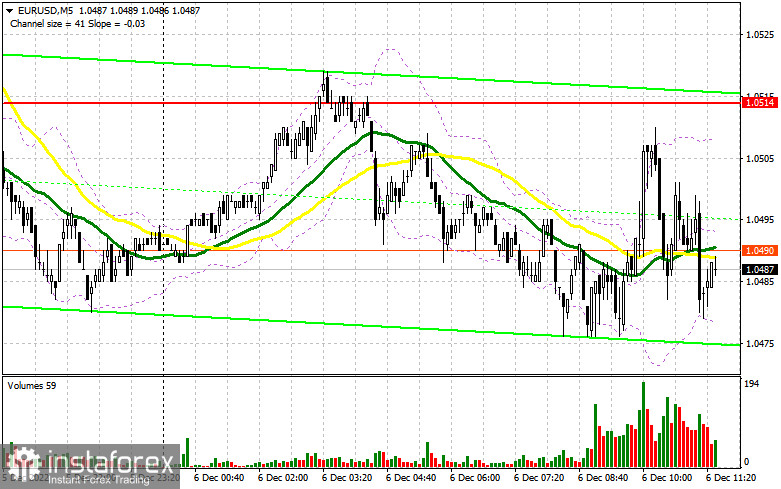In the morning, we focused on the mark of 1.0514 and considered entering the market from there. Let's take a look at the M5 chart to get a picture of what happened. Due to a sharp drop in volatility caused by growing uncertainty about the future of interest rates in the US, there were no entry signals made in the first half of the day. The pair failed to reach any of the outlined levels.

When to go long on EUR/USD:
Investors ignored macro data that came from the eurozone and Germany, as expected. In light of what is now happening in the market, the US statistics will also be of little interest. Therefore, low volatility is expected. It will be followed by a fall in the euro. Thus, it will become possible to go long after a false breakout through 1.0469 support. This will make a buy signal. The EUR/USD pair may then retest the level of 1.0514. Bullish activity may increase if the price breaks and retests this range to the downside. In such a case, the target is seen at 1.0552. Once the quote is above the range, growth may continue to the high of 1.0591, where a profit-taking stage may begin. If EUR/USD goes down during the North American session when there is no bullish activity at 1.0469, the pressure on the euro will increase, a row of bullish stop orders will be triggered, and the uptrend will extend. Therefore, it would be wiser to buy the instrument after a false breakout through 1.0431 support. It will also be possible to open long positions on EUR/USD right after a bounce off 1.0395, or even lower, at 1.0333, allowing a bullish correction of 30-35 pips intraday.
When to go short on EUR/USD:
The lack of demand for the euro may provoke another fall in price. Therefore, it would be cleverer to go short in the second half of the day after a false breakout through 1.0514. This level is not far from the bearish moving averages. A test of this mark may take place at the time US macro data is released. This will create an entry point, and the pair will go down to the nearest support level of 1.0469. A breakout and consolidation below it, with a retest of the range to the upside, will produce an additional signal and trigger a row of bullish stop orders. The pair will plunge to 1.0431 where it would be wiser to engage in profit-taking. A more distant target is seen at 1.0395. If EUR/USD rises during the North American session when there is no bearish activity at 1.0514, the sellers may start leaving the market again. In such a case, bullish activity will increase and the uptrend will resume with the price ascending to 1.0552. Therefore, the smart thing to do would be to go short there after a false breakout only. It will also become possible to sell EUR/USD immediately after a bounce off the 1.0591 high, allowing a bearish correction of 30-35 pips.

Commitments of Traders:
The COT report for November 29 logged an increase in both long and short positions. Jerome Powell's statement last week helped retain demand for risk assets, including the euro. Given that the pair has been on the rise since November, more and more traders are now willing to sell the instrument at the current price. The latest macro data from the US, namely, business activity and labor market indicators, allows traders to expect a continuation of the tightening cycle in the US next year. In this light, there is no good reason to open long positions in the medium term, as the higher the euro climbs, the deeper it will fall. This trading week is likely to be calm, so traders may shift their attention to the FOMC meeting, due on December 13-14. According to the COT report, long non-commercial positions increased by 1,524 to 241,122, and short non-commercial positions grew by 2,389 to 118,875. The weekly total non-commercial net position decreased slightly to 122,234 from 123,112. This indicates that investors are no longer in such a hurry to buy back the undervalued euro as a few months earlier. The weekly closing price advanced to 1.0342 from 1.0315.

Indicator signals:
Moving averages
Trading is carried out below the 30-day and 50-day moving averages, illustrating a bearish bias.
Note: The period and prices of moving averages are viewed by the author on the hourly chart and differ from the general definition of classic daily moving averages on the daily chart.
Bollinger Bands
Support is seen at 1.0469, in line with the lower band.
Indicator description:
- Moving average (MA) determines the current trend by smoothing volatility and noise. Period 50. Colored yellow on the chart.
- Moving average (MA) determines the current trend by smoothing volatility and noise. Period 30. Colored green on the chart.
- Moving Average Convergence/Divergence (MACD). Fast EMA 12. Slow EMA 26. SMA 9.
- Bollinger Bands. Period 20
- Non-commercial traders are speculators such as individual traders, hedge funds, and large institutions who use the futures market for speculative purposes and meet certain requirements.
- Long non-commercial positions are the total long position of non-commercial traders.
- Non-commercial short positions are the total short position of non-commercial traders.
- Total non-commercial net position is the difference between the short and long positions of non-commercial traders.
 English
English 
 Русский
Русский Bahasa Indonesia
Bahasa Indonesia Bahasa Malay
Bahasa Malay ไทย
ไทย Español
Español Deutsch
Deutsch Български
Български Français
Français Tiếng Việt
Tiếng Việt 中文
中文 বাংলা
বাংলা हिन्दी
हिन्दी Čeština
Čeština Українська
Українська Română
Română

